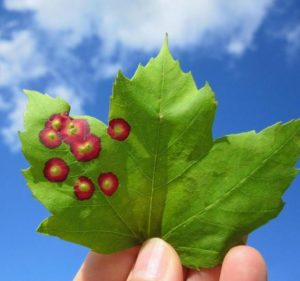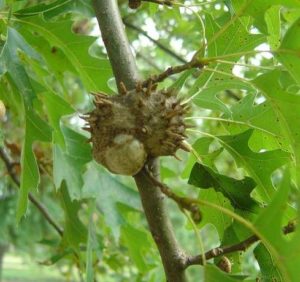Some Insects Have the Gall to Deform Plant Structures
go.ncsu.edu/readext?309911
en Español / em Português
El inglés es el idioma de control de esta página. En la medida en que haya algún conflicto entre la traducción al inglés y la traducción, el inglés prevalece.
Al hacer clic en el enlace de traducción se activa un servicio de traducción gratuito para convertir la página al español. Al igual que con cualquier traducción por Internet, la conversión no es sensible al contexto y puede que no traduzca el texto en su significado original. NC State Extension no garantiza la exactitud del texto traducido. Por favor, tenga en cuenta que algunas aplicaciones y/o servicios pueden no funcionar como se espera cuando se traducen.
Português
Inglês é o idioma de controle desta página. Na medida que haja algum conflito entre o texto original em Inglês e a tradução, o Inglês prevalece.
Ao clicar no link de tradução, um serviço gratuito de tradução será ativado para converter a página para o Português. Como em qualquer tradução pela internet, a conversão não é sensivel ao contexto e pode não ocorrer a tradução para o significado orginal. O serviço de Extensão da Carolina do Norte (NC State Extension) não garante a exatidão do texto traduzido. Por favor, observe que algumas funções ou serviços podem não funcionar como esperado após a tradução.
English
English is the controlling language of this page. To the extent there is any conflict between the English text and the translation, English controls.
Clicking on the translation link activates a free translation service to convert the page to Spanish. As with any Internet translation, the conversion is not context-sensitive and may not translate the text to its original meaning. NC State Extension does not guarantee the accuracy of the translated text. Please note that some applications and/or services may not function as expected when translated.
Collapse ▲Some insects have the gall to deform plant structures
from the NC Forest Service:July 30, 2014

Have you ever seen an abnormal swelling or structure on a plant that normally shouldn’t be there? It probably caused you to scratch your head and wonder what was going on. And if it’s on an ornamental tree in your yard, you probably thought that swelling did not look so swell. It’s possible you were looking at a gall – a condition of abnormal cell development and enlargement caused by insects or other organisms.
To form a gall, chemicals are released by the insect into the plant. These chemicals manipulate the way the plant grows, altering its structure to benefit the insect. For example, they may cause changes that provide nutrients or shelter needed for survival. They say a change would do you good, but in this case, a change does the insect good! Galls come in many shapes, colors, sizes, textures and longevity. Many are so characteristic that one can determine the causal insect/agent just by looking at the features.
While there are many kinds of gall-forming insects (e.g., aphids, wasps, midges, beetles, sawflies, adelgids), they are typically species specific, meaning they cause gall formation in a specific species or group of plants. For example, the larvae of the maple eyespot gall midge (a small fly) form round, often reddish, “bulls-eye” patterned galls on the leaves of red maples (pictured). No other organisms will cause that and the midge typically does not infest other tree species.
Galls can be seen on any part of the plant: leaves, flowers, twigs and branches, shoots, main stems and buds. But not to worry—despite the alarming appearance, galls typically cause aesthetic damage only. Because they cause little or no harm to their host plant, management is typically not recommended.





